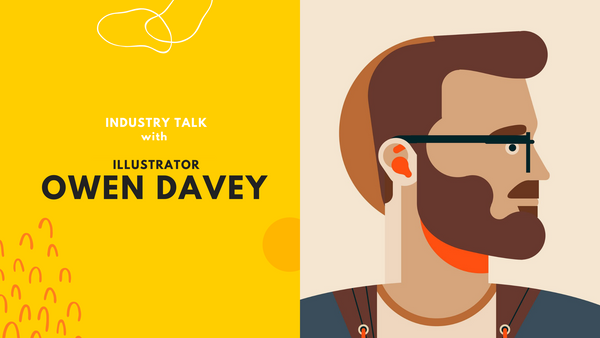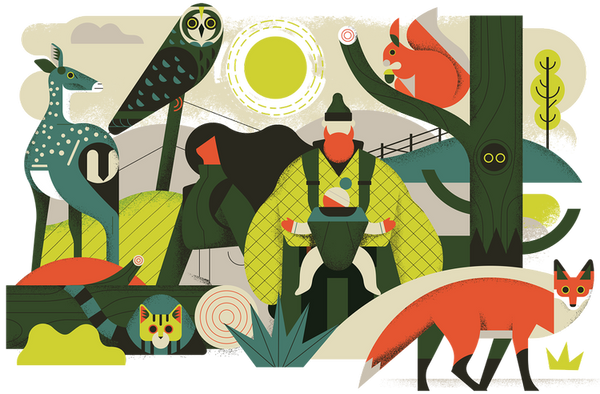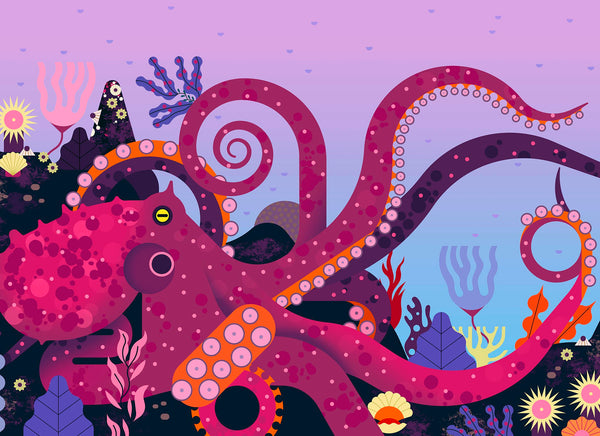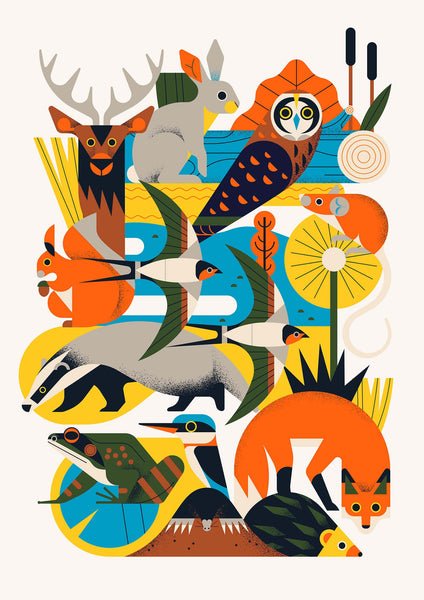INDUSTRY TALK with illustrator Owen Davey

I’m really excited to introduce this month’s Industry Talk guest as I had the extreme privilege to interview illustrator, educator and fellow AOI mentor Owen Davey!
Owen and I had the best chat talking about style, favourite things to draw, being a professional illustrator and dream projects.
So without further ado, let’s jump in!
Q - So Owen, for our readers who might not be familiar with your work and who you are, how did you get into illustration?
A - I always liked drawing as a kid, that's what I did in my spare time. When I was asked what I wanted to do when I grew up I said that I wanted to write and draw pictures for kids books, and I just never deviated from that path. I studied at college and at uni, and then didn't try to do anything else after uni, I just tried to be an illustrator. So, sort of a direct path but I just knew what I wanted to do. I mean... I didn't know what an illustrator was when I kind of knew what I wanted to do, but when I learned what it was, I was like ‘Oh yeah that's it, that's the thing I'm going to do!’
Q - I think what's striking about your work is the composition, the shapes, and the colours. And I was wondering if that's something that you developed in more recent years, or is that something that was always there?
A - No, it's something I've developed I think. Because I've always drawn, I've kind of tried everything out. I used to paint, I went through that phase of trying to make everything look as realistic as possible. And then I realised that it was way more interesting to actually infer things or, you know, explore stuff a bit more. And I think at uni they were really good at teaching us the fundamentals: they taught us about composition, about how it can draw the eye, how it can have certain connotations towards how you perceive the piece, and then how different colours have connotations and how that may be adapted in different cultures and things like that as well.
Actually, I didn't like it when they first taught it to us. I used to find it so dull, but actually it really stuck with me and I started to play with it more.
And then there’s geometry. Basically I had a harder sort of realisation where I started to realise that actually, I didn't want to draw things anymore, I wanted to design them. And so it wasn't just like putting pencil to paper and drawing a box anymore, I would think ‘How can I play around with how I draw that box? How can I really explore it?’ I was stylizing before, but suddenly I wanted to see how far I could push it.
My current style developed over the years and probably got more refined and geometrical, and the colour theory has definitely improved! I've worked out how I can use it in different ways and come up with tactics for how to make a colour palette work together with lots of different colours for example.
So yeah, my current illustration style is very much derived from my practice but there were a few little eureka moments along the way too.

Image credits: Owen Davey - cover for a Telegraph section about Winter Wildlife Walks
Q - Do you have a favourite thing to draw?
A - I think it’s pretty much animals. I find animals endlessly interesting so I really like drawing them and that's become kind of ‘my thing’ as an illustrator. Although I think mammals are the hardest to draw. As a species we (humans) are very good at patterns and we understand when something looks a little bit off with humans and other mammals that we're very used to seeing. But then when you get to fish and birds. I think because they're so vastly different from our general life, you can get away with a lot more. So I often draw fish with a really abstract shape or I draw a bird's leg as a line or a wiggly thing, and you don't notice it being weird because you're not used to seeing them as much.
Q - Do you have any piece of advice for the illustrators who are maybe still in the early stages of their career and who may be struggling with style?
A - I try to avoid using the word style because it evolves. I prefer to think about it as the ‘way of working that you like’. People tend to be very focused on the final artwork and actually I think that the process behind that (the ideas, the research, all that stuff) is way more important. Sure, you need a good finished product. But some of that stuff behind the finished product gives it depth, that little something a bit more extra special.
So then my advice to people who are struggling with their style is this: usually people have got a few different ways that they like working in, and so I have this tier system that helps you refine it down. In the top tier the most important thing is ‘Which one of these styles do you love the most?’ If you have an answer for that, that is your style. End of the story. Go with that push that as far as you can.
If you have a few styles that you love working in then drop down to the next tier: if you want to make this a business then you have to think about its commercial viability and how many different areas that style can be used in. For example, you may think ‘This one can be used in children's books, but that one can be used in children's books AND probably lots of other publishing, and maybe some advertising.’ So it makes sense to take that one.
Then if you've got a few styles that reached the bottom tier, ask yourself: ‘Which one takes the least amount of time?’ Because if you've got the same amount of passion for it and they can provide the same sort of opportunities for you in the industry, then you have to think about it really logically. If with this style I can make the artwork in half the time as that other style, I'm going to be able to make more money and I can be more creative because I've got more time to do this other stuff.
This is a really logical way of approaching it, but I think that if your heart is confused, then go with the logic. Take that bottom tier style that you think is the best one and run with it for a few months. Everything you do, try and do it in that way and see its limitations, see how far you can take it. See where it doesn't work, see where it does work. And if by the end of those three months (or whatever time you’ve assigned to it) you still love it. If so, great, carry on with it! If not, maybe go back, see what it is that you're missing from the other stuff and see if you can bring that in, or swap out totally. You know, especially early on in your career, it's quite easy to swap stuff out, whereas later on I think you have to do it more gradually in order to retain your commissions.
Q - Do you have any advice for illustrators who might struggle with pricing their work?
A - Think like a professional. Make use of the resources available, like the AOI mentorship for example. I think that things like that are really valuable because with experience comes knowledge and, you know, even if you feel like a fraud or like you’re not worth it, at least you know what's an industry standard.
Also, most of the time you're working by email. I've never quoted anybody over the phone ever, because 1) I haven't got any evidence of it there, and 2) I don't want to think about it off the top of my head. When people ask me for quotes over the phone I ask them to email me the details so that I can have a think about it and get back to them. Once you've got the information, you have time to actually review what you're doing, and you can see if you're falling into bad habits like underselling yourself or not allowing enough time for example. You can send your quote to the AOI to get their opinion on it, or you can ask any fellow illustrators that you might know what they think. It’s normal to doubt yourself at times. It can happen several times throughout your career. It tends to go away for a while and it comes back. That’s why surrounding yourself with people you can turn to for help is important.

Image credits: Owen Davey - artwork from his book 'Obsessive About Octopuses'. Also available as a print here.
Q - Could you share a past mistake or a challenge that you’ve faced, and how you’ve overcome it?
A - Sure. It's a really hard one and I'm not entirely sure, but there are a few jobs that I have done in the past that maybe should have gone to someone who's under-represented in the industry or someone who has that experience or that type of insight that I didn’t have, rather than me doing my research and hopefully getting it right. I think that generally I've got it right most of the time when I do my own research but if someone else has given me research it can go wrong. Basically, now usually when those kinds of jobs come in I will say ‘Thanks but I don't think I'm right for that.’ And I try to recommend someone that I think would be a better fit.
Q - If you could go back in time, what’s a piece of advice you would give your younger self?
A - This is a weird answer and it may sound cocky, but I don't think I'd want to give my younger self any advice because I'm pleased with where I got to and I wouldn’t want to mess with that. But I guess the advice that I generally give younger people is to stick up for themselves because doing so is good for them, it’s good for the people who might rely on them for income, and it’s also good for the industry as a whole. You know, if you're getting paid well it means that clients are paying the going rate and that’s also good for other illustrators. I also advise them to challenge commissioners when they're asking for problematic things.
Q - On the FAQ page on your website, there's a piece of advice where you say: “Be easy to work with, but also stand up for yourself.” When you're just getting started this can seem contradictory. Could you explain a little bit what you mean by “Be easy to work with, but also stand up for yourself” for our readers?
A - Of course. I essentially mean professionalism. I've been told by clients before that I can sometimes seem blunt in emails but that they quite like it in a way. That’s because I don't faff around with the things I want to say, like: ‘I don't agree with you on this one, I think we should do this.’ The client knows exactly where they stand with it and I'm not being awkward for the sake of it. I'm just standing up for myself and for what I think is necessary or beneficial for the project. But I also always meet deadlines. If I'm going to have issues with meeting the deadline and I’ve realised that it's a mistake, then I will extend the deadline, which I don't see as missing the deadline: I'm simply adjusting the parameters. If the client can't change the deadline and it’s my fault then I’ll do an all-nighter if that’s what it takes to make it work. Equally, if a client comes back and says ‘We want these edits,’ and it's their fault, then they're paying for it. I'm not bending over backwards for their own whims but I'm being professional and doing my job.
Q - What’s one of your favourite projects that you’ve worked on?
A - Can I give you two?
So the first one: I've been doing these books with Flying Eye Books for the last eight years or so. They’re nonfiction illustrated books for kids about animals, and each one focuses on different types of species like crocodiles, sharks, monkeys, etc. These books have been like my proper little babies. I've researched them, I've written them, I've illustrated them. I've obviously worked with an amazing team, who edited them, did the typeset and, you know, made the books kind of successes as well, but I pour my heart and soul into them, they're really hard work and yet I really love them.
The second project: I've been working on an app called Two Dots since 2015. Both of those two projects kind of started at the same time and I'm still working on both of them. I cannot not mention Two Dots because it's been a huge project for me. They originally contacted me and asked to see some test illustrations. I was really busy at the time so I said no. Luckily, the art director came back and offered more money. At the time I was really strapped for time, so once again I apologised and turned it down. Then luckily the art director came back again and offered me more time AND more money, and so I took that tester job. They didn't quite like what I came up with but they liked the energy and my ideas, and so they brought me on for the full project. I've been doing that for six or seven years and it's essentially paid for the studio I'm sitting in. And, you know, they're so lovely to work with! I've worked with a number of amazing creatives and art directors there, and it's really fun to work on and to get to draw cool stuff.
You never really know where a project will take you!
Q - What’s a dream project that you would just LOVE to work on?
A - Can I give you two again?
I’d love to create the branding for the Green Man Festival one year. I’m not sure my work is the right fit for it, but it would be a lot of fun!
And then I would love to create artwork for one of those big themed malls like the ones you see in Asia, with 3D artwork and all. It looks so fun, so badass,... I would LOVE to do that!

Image credits: Owen Davey - created for 'The Green Show' an exhibition put on by SCIP
Where to find Owen Davey online:
Website: www.owendavey.com
Instagram: @owendaveydraws
Image credits: ©Owen Davey
